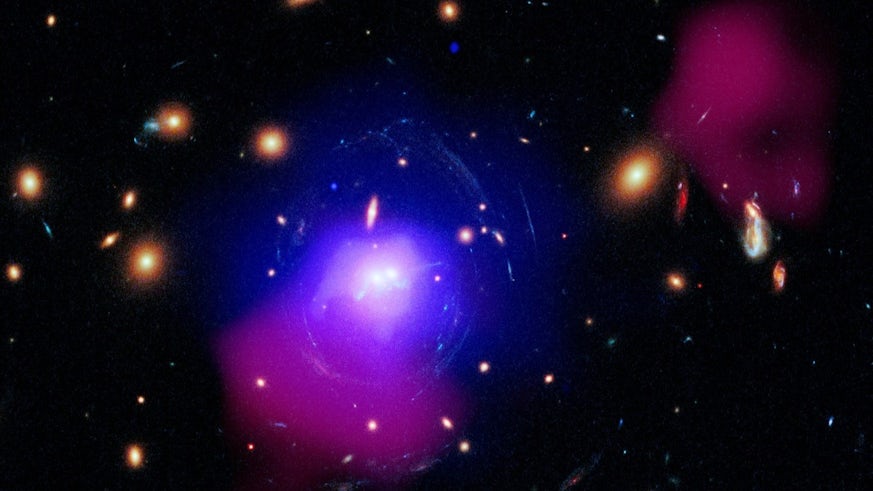Black hole fashions stellar beads on a string
21 February 2024

One of the most powerful eruptions from a black hole ever recorded has been discovered by an international team of astronomers.
The mega-explosion, which took place billions of years ago, may help explain the formation of a pattern of star clusters resembling beads on a string, according to the study.
This stellar jewellery is located in SDSS J1531, a massive galaxy cluster 3.8 billion light-years from Earth, containing hundreds of individual galaxies and a huge reservoir of hot gas and dark matter.
At the heart of SDSS J1531, two of the cluster’s largest galaxies are colliding with one another.
These colliding giants are surrounded by a set of 19 large clusters of stars, called superclusters, arranged in an ‘S’ formation that resembles a string of beads.
The team used a combination of X-ray, radio, and optical data to understand how this unusual chain of star clusters formed.
Their findings, presented in The Astrophysical Journal, can help shed light on how black holes regulate their environments, acting as cosmic thermostats to keep the gas in galaxy clusters from collapsing and forming stars.

Black hole eruptions, like the one that helped create the superclusters in SDSS J1531, are predicted to be very important in keeping the gas in galaxy clusters hot. Finding such clear evidence of this process ongoing allows us to understand the impact of monster black holes on their environments.
According to the team, the eruption likely occurred when the supermassive black hole in the centre of one of SDSS J1531’s large galaxies produced an extremely powerful jet.
As the jet moved through space, it pushed the surrounding hot gas away from the black hole, creating a gigantic cavity, the authors claim.
Osase Omoruyi, who led the study at the Center for Astrophysics – a collaboration between the Smithsonian Astrophysical Observatory and Harvard College Observatory, said: “We are already looking at this system as it existed four billion years ago, not long after the Earth formed.
“This ancient cavity, a fossil of the black hole, tells us about a key event that happened nearly 200 million years earlier in the cluster’s history.”
The team reconstructed the sequence of events using NASA’s Chandra X-ray Observatory and the Low Frequency Array (LOFAR), a radio telescope.
They tracked the dense gas near the centre of SDSS J1531 revealing “wings” of bright X-ray emission at the edge of a cavity.
Combined with radio waves detected by LOFAR from the remains of the jet’s energetic particles, the team had compelling evidence of an ancient, massive explosion.
Dr Davis added: “This system clearly has a very active black hole, which repeatedly erupts, and is strongly affecting the gas around it. Here we detect the smoking gun, and see its impact all at once.”
Black holes usually fire two jets in opposite directions but so far, the team has only detected one.
They think that radio and X-ray signals observed further away from the galaxies might be the leftovers from a second jet.
“We think our evidence for this huge eruption is strong, but more observations with Chandra and LOFAR would clinch the case,” said Omoruyi.
“We hope to learn more about the origin of the cavity we’ve already detected, and find the one expected on the other side of the black hole.”
The paper, ‘"Beads on a String" Star Formation Tied to one of the most Powerful AGN Outbursts Observed in a Cool Core Galaxy Cluster’ is published in The Astrophysical Journal.
Share this story
It is a friendly, approachable School with a strong commitment to teaching excellence and world class research in physics and astronomy.



